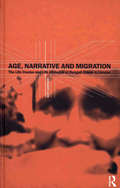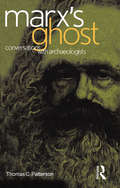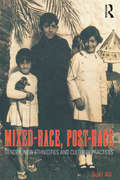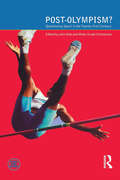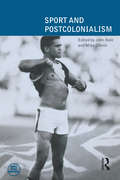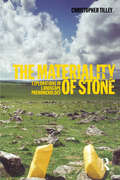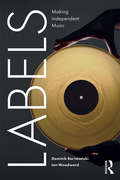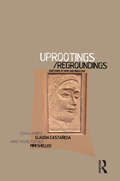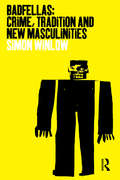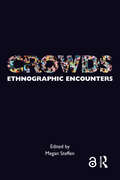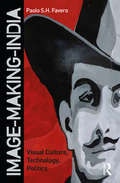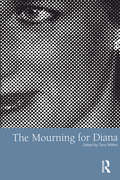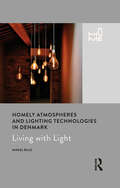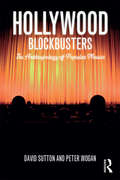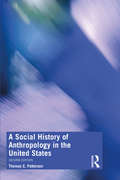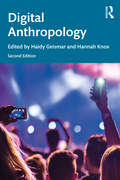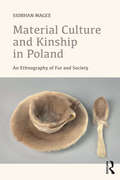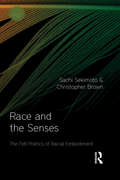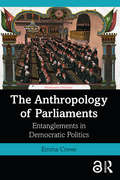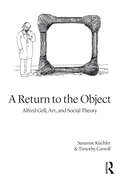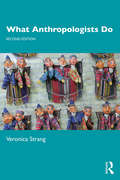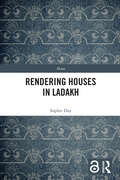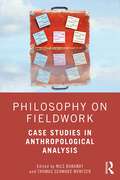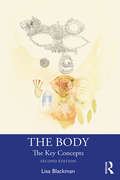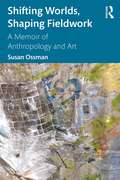- Table View
- List View
Age, Narrative and Migration: The Life Course and Life Histories of Bengali Elders in London
by Katy GardnerWhilst the vast majority of recent research on identity and ethnicity amongst South Asians in Britain has focused upon younger people, this book deals with Bengali elders, the first generation of migrants from Sylhet, in Bangladesh. The book describes how many of these elders face the processes of ageing, sickness and finally death, in a country where they did not expect to stay and where they do not necessarily feel they belong. The ways in which they talk about and deal with this, and in particular, their ambivalence towards Britain and Bangladesh lies at the heart of the book. Centrally, the book is based around the men and womens life stories. In her analysis of these, Gardner shows how narratives play an important role in the formation of both collective and individual identity and are key domains for the articulation of gender and age. Underlying the stories that people tell, and sometimes hidden within their gaps and silences, are often other issues and concerns. Using particular idioms and narrative devices, the elders talk about the contradictions and disjunctions of transmigration, their relationship with and sometimes resistance to, the British State, and what they often present as the breakdown of traditional ways. In addition to this, the book shows that histories, stories and identity are not just narrated through words, but also through the body - an area rarely theorized in studies of migration.
Marx's Ghost: Conversations with Archaeologists
by Thomas C. PattersonHow did our current society come into being and how is it similar to as well as different from its predecessors? These key questions have transfixed archaeologists, anthropologists and historians for decades and strike at the very heart of intellectual debate across a wide range of disciplines. Yet scant attention has been given to the key thinkers and theoretical traditions that have shaped these debates and the conclusions to which they have given rise. This pioneering book explores the profound influence of one such thinker - Karl Marx - on the course of twentieth-century archaeology. Patterson reveals how Australian archaeologist V. Gordon Childe in the late 1920s was the first to synthesize discourses from archaeologists, sociologists, and Marxists to produce a corpus of provocative ideas. He analyzes how these ideas were received and rejected, and moves on to consider such important developments as the emergence of a new archaeology in the 1960s and an explicitly Marxist strand of archaeology in the 1970s. Specific attention is given to the discussion arenas of the 1990s, where archaeologists of differing theoretical perspectives debated issues of historic specificity, social transformation, and inter-regional interaction. How did the debates in the 1990s pave the way for historical archaeologists to investigate the interconnections of class, gender, ethnicity, and race? In what ways did archaeologists make use of Marxist concepts such as contradiction and exploitation, and how did they apply Marxist analytical categories to their work? How did varying theoretical groups critique one another and how did they overturn or build upon past generational theories?Marxs Ghost: Conversations with Archaeologists provides an accessible guide to the theoretical arguments that have influenced the development of Anglophone archaeology from the 1930s onwards. It will prove to be indispensable for archaeologists, historians, anthropologists, and social and cultural theor
Mixed-Race, Post-Race: Gender, New Ethnicities and Cultural Practices
by Suki AliSocial scientists claim that we now live in a post-race society, where race has been replaced by 'ethnicity'. Yet racism is endemic to British society and people often think in terms of black and white. With a marked rise in the number of children from mixed parentage, there is an urgent need to challenge simplistic understandings of 'race', nation and culture, and interrogate what it means to grow up in Britain and claim a 'mixed' identity. Focusing on mixed-race and inter-ethnic families, this book not only explores current understandings of 'race', but it shows, using innovative research techniques with children, how we come to read race. What influence do photographs and television have on childrens ideas about 'race'? How do children use memories and stories to talk about racial differences within their own families? How important is the home and domestic culture in achieving a sense of belonging? Ali also considers, through data gathered from teachers and parents, broader issues relating to the effectiveness of anti-racist and multicultural teaching in schools, and parental concerns over the social mobility and social acceptability of their children. Rigorously researched, this book is the first to combine childrens accounts on 'race' and identity with contemporary cultural theory. Using fascinating case studies, it fills a major gap in this area and provides an original approach to writing on race.
Post-Olympism: Questioning Sport in the Twenty-First Century (Global Sport Cultures Ser.)
by John BaleThe Olympic ideal and the Olympic Games stand as symbols of global cooperation, international understanding and the bonding of individuals through the medium of sports. However, throughout the twentieth century, Olympic rhetoric was often confronted by a different reality. The Games have regularly been faced by crises that have threatened the spirit of Olympism and even the Games themselves. Given the many changes that have occurred in the Olympic Games during the past century it seems reasonable to ask if this global event has a future and, if so, what form it might take. With this larger issue in mind, the authors of Post-Olympism? ask probing questions about the following: the infamous 1936 Olympics the effect of new technologies on the Games the future impact of the 2008 Beijing Games on China and of China on the Olympics the local and regional impact of the Sydney green Olympics the Games and globalization Disneyfication racism drug abuse The book provides a useful overview of the ongoing significance of the Olympics and will be essential reading for anyone with a serious interest in the Games.
Sport and Postcolonialism
by John BaleCompared with modes of representation such as literature, drama, poetry and dance, the world of sport has been largely neglected in postcolonial studies. At both local and global levels, however, sport has been profoundly affected by the colonial legacy. How are individual nations and different sporting cultures coping with this legacy? What does the end of colonialism mean within particular states and sports? How is postcolonialism linked with struggles of race and identity?Sport was a major tool of colonial power and postcolonialism manifests itself in the modern sporting world in several ways, including the huge number of world class athletes from former European empires and the exploitation of child-workers in postcolonial nations by the sporting goods industries. Many former colonial states place considerable importance on elite sport as a form of representation, yet a small number of such states oppose sport in its western form. This book explores the wealth of issues and experiences that comprise the postcolonial sporting world and questions whether sport can act as a form of resistance in postcolonial states and, if so, how such resistance might manifest itself in the rule-bound culture of sport.Its novel approach and topical focus makes this book essential reading for anyone interested in contemporary sports, postcolonialism, race and ethnic studies.
The Materiality of Stone: Explorations in Landscape Phenomenology
by Christopher TilleyWith Wayne Bennett From the silky wax qualities of the surfaces of some quartz menhirs to the wood-grain textures of others, to the golden honeycombed limestones of Malta, to the icy frozen waves of the Cambrian sandstone of south-east Sweden, this book investigates the sensuous material qualities of stone. Tactile sensations, sonorous qualities, colour, and visual impressions are all shown to play a vital part in our understanding of the power and significance of prehistoric monuments in relation to their landscapes. In The Materiality of Stone, Christopher Tilley presents a radically new way of analyzing the significance of both 'cultural' and 'natural' stone in prehistoric European landscapes. Tilley's groundbreaking approach is to interpret human experience in a multidimensional and sensuous human way, rather than through an abstract analytical gaze. The studies range widely from the menhirs of prehistoric Brittany to Maltese Neolithic temples to Bronze Age rock carvings and cairns in southern Sweden. Tilley leaves no stone unturned as he also considers how the internal spaces and landscape settings are interpreted in relation to artifacts, substances, and related places that were deeply meaningful to the people who inhabited them and remain no less evocative today. In its innovative approach to understanding human experience through the tangible rocks and stone of our past, The Materiality of Stone is both a major theoretical and substantive contribution to the field of material culture studies and the study of European prehistory.
Labels: Making Independent Music (Criminal Practice Ser.)
by Ian Woodward Dominik BartmanskiThe music industry is dominated today by three companies. Outside of it, thousands of small independent record labels have developed despite the fact that digitalization made record sales barely profitable. How can those outsiders not only survive, but thrive within mass music markets? What makes them meaningful, and to whom? Dominik Bartmanski and Ian Woodward show how labels act as taste-makers and scene-markers that not only curate music, but project cultural values which challenge the mainstream capitalist music industry. Focusing mostly on labels that entered independent electronic music after 2000, the authors reconstruct their aesthetics and ethics. The book draws on multiple interviews with labels such as Ostgut Ton in Berlin, Argot in Chicago, 100% Silk in Los Angeles, Ninja Tune in London, and Goma Gringa in Sao Paulo. Written by the authors of Vinyl, this book is essential reading for anyone with an interest in the contemporary recording industry, independent music, material culture, anthropology, sociology, and cultural studies.
Uprootings/Regroundings: Questions of Home and Migration
by Sara AhmedNew forms of transnational mobility and diasporic belonging have become emblematic of a supposed ‘global' condition of uprootedness. Yet much recent theorizing of our so-called ‘postmodern' life emphasizes movement and fluidity without interrogating who and what is ‘on the move'. This original and timely book examines the interdependence of mobility and belonging by considering how homes are formed in relationship to movement. It suggests that movement does not only happen when one leaves home, and that homes are not always fixed in a single location. Home and belonging may involve attachment and movement, fixation and loss, and the transgression and enforcement of boundaries. What is the relationship between leaving home and the imagining of home itself? And having left home, what might it mean to return? How can we re-think what it means to be grounded, or to stay put? Who moves and who stays? What interaction is there between those who stay and those who arrive and leave? Focusing on differences of race, gender, class and sexuality, the contributors reveal how the movements of bodies and communities are intrinsic to the making of homes, nations, identities and boundaries. They reflect on the different experiences of being at home, leaving home, and going home. They also explore ways in which attachment to place and locality can be secured - as well as challenged - through the movements that make up our dwelling places.Uprootings/Regroundings: Questions of Home and Migration is a groundbreaking exploration of the parallel and entwined meanings of home and migration. Contributors draw on feminist and postcolonial theory to explore topics including Irish, Palestinian, and indigenous attachments to ‘soils of significance'; the making of and trafficking across European borders; the female body as a symbol of home or nation; and the shifting grounds of ‘queer' migrations and ‘creole' identities.This innovative analysis will open up avenues of research an
Badfellas: Crime, Tradition and New Masculinities
by Simon WinlowFights, fraud and drugs racketeering regularly hit the headlines, but they are just news stories for most of us. For others, they constitute a way of life. This book uncovers a world where male identity is expressed each day through physical strength and power. Focusing on professional criminals and violent men, the author shows how workshop camaraderie, hard physical work and criminal reputations allow for changing masculinities. It is all too easy to stereotype criminals, when, in fact, their world is complex and creative. Criminal men adapt and modify their forms of gender expression to fit in with their changing economic, social and cultural circumstance, as do men in all walks of life. Why is violence attractive to these men? What motivates their crimes, both planned and impulsive? How do criminals themselves view their activities and their reputations, and how do these reputations affect their perception of masculinity? This book is the first sustained analysis of organized crime and violence to use covert research methods. Far from the sensationalized memoirs of retired gangsters, or the abstract discussions of scholars, this book builds on first-hand experiences and relationships made while working amongst bouncers and criminals. The social world of professional criminals and the working environments of criminal bouncers are demystified and laid bare. The author sets individual criminal careers and experiences in the wider context of de-industrialization and globalization, and provides a thoughtful and stimulating addition to the fields of anthropology, sociology and criminology.
Crowds: Ethnographic Encounters (Encounters: Experience and Anthropological Knowledge)
by Megan SteffenWhat exactly is a crowd? How do crowds differ from other large gatherings of people? And how do they transform emotions, politics, or faith? In Crowds, contributors draw on their experiences and expertise to reflect on their encounters with crowds. Each chapter examines a particular crowd or conception of crowdedness to provide an analysis of how, when, where—and with whom—crowds form in different contexts, as well as their purpose and the practical effect the experience has on both the participants and their environment. The wide selection of case studies ranges from the crowds that form every year during the Hajj, to New Year celebrations in China, commuters on the Delhi metro, public prayer in Nigeria, online mobs in Bangladesh, and the crowds that have emerged during protest movements in Thailand and Syria. Crowds makes a key contribution to establishing an anthropological theory of crowds and will be an essential read for both students and researchers.
Image-Making-India: Visual Culture, Technology, Politics
by Paolo Silvio FaveroImage-Making-India explores the evolving meaning of images in a digital landscape from the vantage point of contemporary India. Building upon long-term ethnographic research among image-makers in Delhi, Mumbai and other Indian cities, the author interrogates the dialogue between visual culture, technology and changing notions of political participation. The book explores selected artistic experiences in documentary and fiction film, photography, contemporary art and digital curation that have in common a desire to engage with images as tools for social intervention. These experiences reveal images’ capacity not only to narrate and represent but also to perform, do and affect. Particular attention is devoted to the 'digital', a critical landscape that offers an opportunity to re-examine the significance of images and visual culture in a rapidly changing India. This volume will be of particular interest to scholars of visual and digital anthropology and cultures as well as South Asian studies.
The Mourning for Diana
by Tony WalterThe unexpected death of Diana, Princess of Wales, in Paris on August 31st 1997 led to a period of mourning over the next week that took the world by surprise. Major institutions - the media, the royal family, the church, the police - for once had no pre-planned script. For the public, this was a story with an ending they had not anticipated. How did these institutions and the public create a cultural order in the face of such disorder? Both those involved in the mourning and those who objected to it struggled to understand the depth and breadth of emotion shaking Britain and the world. Mourning was focused on London, where Diana's body lay, and on Diana's home, Kensington Palace. Throughout the city and especially in Kensington Gardens, millions left shrines to the dead princess made of flowers, messages, teddy bears and other objects. In towns and villages around the UK, this was repeated. The mourning was also global, with media dominated by Diana's death in scores of countries. The funeral itself had a record-breaking world television audience, and messages of condolence floated around the globe in cyber-space. How unique was all this? Does it mark a shift in the culture of mourning, of the position of the monarchy, of the role of emotion in British culture? How does it compare with the mourning for other super-icons - JFK, Evita, Elvis, and Monroe? Was it media-induced hysteria? Or was it simply a magnification of normal mourning behaviour? Focusing on the extraordinary actions of millions of ordinary people, this book documents what happened and shows how a modern rational society coped with the unexpected in a proto-revolutionary week that left participants and objectors alike asking 'why did we behave like this?'
Homely Atmospheres and Lighting Technologies in Denmark: Living with Light (Home)
by Mikkel BilleUsing case studies, such as the use of candlelight and energy saving lightbulbs in Denmark, this book unravels light’s place at the heart of social life. In contrast to common perception of light as a technical and aesthetic phenomenon, Mikkel Bille argues that there is a cultural and social logic to lighting practices. By empirically investigating the social role of lighting in people's everyday lives, Mikkel Bille reveals how and why people visually shape their homes. Moving beyond the impact of its use, Bille also comments on the politics of lighting to examine how ideas of pollution and home act as barriers for technological fixes to curb energy demand. Attitudes to these issues are reflective of how human perceptions and practices are central to the efforts to cope with climate change. This ethnographic study is a must-read for students of anthropology, cultural studies, human geography, sociology and design.
Hollywood Blockbusters: The Anthropology of Popular Movies
by Peter Wogan David SuttonCertain Hollywood movies are now so deeply woven into the cultural fabric that lines of their dialogue - for example, 'Make him an offer he can't refuse' - have been incorporated into everyday discourse. The films explored in this book, which include The Godfather, Jaws, The Big Lebowski, Field of Dreams and The Village, have become important cultural myths, fascinating windows into the schisms, tensions, and problems of American culture. Hollywood Blockbusters: The Anthropology of Popular Movies uses anthropology to understand why these movies have such enduring appeal in this age of fragmented audiences and ever-faster spin cycles. Exploring key anthropological issues from ritual, kinship, gift giving and totemism to literacy, stereotypes, boundaries and warfare, this fascinating book uncovers new insights into the significance of modern film classics for students of Film, Media, Anthropology and American Cultural Studies.
A Social History of Anthropology in the United States
by Thomas C. PattersonThis book offers a comprehensive introduction to the social history of anthropology in the United States, examining the circumstances that gave rise to the discipline and illuminating the role of anthropology in the modern world. Thomas C. Patterson considers the shifting social and political-economic conditions in which anthropological knowledge has been produced and deployed, the appearance of practices focused on particular regions or groups, the place of anthropology in structures of power, and the role of the educator in forging, perpetuating, and changing representations of past and contemporary peoples. The book addresses the negative reputation that anthropology took on as an offspring of imperialism, and provides fascinating insight into the social history of America. In this second edition, the material has been revised and updated, including a new chapter that covers anthropological theory and practice during the turmoil created by multiple ongoing crises at the beginning of the twenty-first century. This is valuable reading for students and scholars interested in the origins, development, and theory of anthropology.
Digital Anthropology
by Haidy Geismar; Hannah KnoxDigital Anthropology, 2nd Edition explores how human and digital can be explored in relation to one another within issues as diverse as social media use, virtual worlds, hacking, quantified self, blockchain, digital environmentalism and digital representation. The book challenges the prevailing moral universal of “the digital age” by exploring emergent anxieties about the global spread of new technological forms, the cultural qualities of digital experience, critically examining the intersection of the digital to new concepts and practices across a wide range of fields from design to politics. In this fully revised edition, Digital Anthropology reveals how the intense scrutiny of ethnography can overturn assumptions about the impact of digital culture and reveal its profound consequences for everyday life around the world. Combining case studies with theoretical discussion in an engaging style that conveys a passion for new frontiers of enquiry within anthropological study, this will be essential reading for students and scholars interested in theory of anthropology, media and information studies, communication studies and sociology. With a brand-new Introduction from editors Haidy Geismar and Hannah Knox, as well as an abridged version of the original Introduction by Heather Horst and Daniel Miller, in conjunction with new chapters on hacking and digitizing environments, amongst others, and fully revised chapters throughout, this will bring the field-defining overview of digital anthropology fully up to date.
Material Culture and Kinship in Poland: An Ethnography of Fur and Society
by Siobhan MageeIn this ethnography of Krakowian society, Siobhan Magee explores essential questions on the relationship between fur and culture in Poland. How can wearing a fur coat indicate someone's political views in Krakow, beyond their opinion on animal rights? What kinds of associations are given to someone wearing a fur coat in Poland? And what impact does generational difference have on the fur-wearing traditions of modern day Krakowians? Magee looks further into detailed analyses of conversations held relating to fur, including why fur is an apt inheritance for a grandmother to pass on to her granddaughter; what it was like trading fur on 'black markets' during socialism, and why some anti-fur activists link fur to patriarchal power and the Roman Catholic Church. In so doing, it becomes clear how fur is an evocative textile with an uncommonly rich symbolic and historical significance."Magee's research uncovers the symbolic and historic significance that fur evokes in relation to culture in Poland. In her investigations, her ethnography becomes a means for understanding generational difference in Poland. Written with reference to extensive fieldwork, Magee goes on to show how the classification of generation can be a much more accessible indicator and measure of difference than other categories, including sexuality, class and faith. Thus, 'generation' and 'inheritance' are shown to be uniquely powerful idioms with which to discuss power and social change in Poland. A new contribution to material culture and the sensory turn, this will be of interest to scholars of anthropology, ethnography, eastern Europe and material culture and textiles.
Race and the Senses: The Felt Politics of Racial Embodiment (Sensory Studies)
by Sachi Sekimoto Christopher BrownIn Race and the Senses, Sachi Sekimoto and Christopher Brown explore the sensorial and phenomenological materiality of race as it is felt and sensed by the racialized subjects. Situating the lived body as an active, affective, and sensing participant in racialized realities, they argue that race is not simply marked on our bodies, but rather felt and registered through our senses. They illuminate the sensorial landscape of racialized world by combining the scholarship in sensory studies, phenomenology, and intercultural communication. Each chapter elaborates on the felt bodily sensations of race, racism, and racialization that illuminate how somatic labor plays a significant role in the construction of racialized relations of sensing. Their thought-provoking theorizing about the relationship between race and the senses include race as a sensory assemblage, the phenomenology of the racialized face and tongue, kinesthetic feelings of blackness, as well as the possibility of cross-racial empathy. Race is not merely socially constructed, but multisensorially assembled, engaged, and experienced. Grounded in the authors’ experiences, one as a Japanese woman living in the USA, and the other as an African American man from Chicago, Race and the Senses is a book about how we feel the racialized world into being.
The Anthropology of Parliaments: Entanglements in Democratic Politics
by Emma CreweThe Anthropology of Parliaments offers a fresh, comparative approach to analysing parliaments and democratic politics, drawing together rare ethnographic work by anthropologists and politics scholars from around the world. Crewe’s insights deepen our understanding of the complexity of political institutions. She reveals how elected politicians navigate relationships by forging alliances and thwarting opponents; how parliamentary buildings are constructed as sites of work, debate and the nation in miniature; and how politicians and officials engage with hierarchies, continuity and change. This book also proposes how to study parliaments through an anthropological lens while in conversation with other disciplines. The dive into ethnographies from across Africa, the Americas, Asia, Europe, the Middle East and the Pacific Region demolishes hackneyed geo-political categories and culminates in a new comparative theory about the contradictions in everyday political work. This important book will be of interest to anyone studying parliaments but especially those in the disciplines of anthropology and sociology; politics, legal and development studies; and international relations.
A Return to the Object: Alfred Gell, Art, and Social Theory
by Susanne Kuechler Timothy CarrollThis book draws on the work of anthropologist Alfred Gell to reinstate the importance of the object in art and society. Rather than presenting art as a passive recipient of the artist's intention and the audience's critique, the authors consider it in the social environment of its production and reception. A Return to the Object introduces the historical and theoretical framework out of which an anthropology of art has emerged, and examines the conditions under which it has renewed interest. It also explores what art 'does' as a social and cultural phenomenon, and how it can impact alternative ways of organising and managing knowledge. Making use of ethnography, museological practice, the intellectual history of the arts and sciences, material culture studies and intangible heritage, the authors present a case for the re-orientation of current conversations surrounding the anthropology of art and social theory. This text will be of key interest to students and scholars in the social and historical sciences, arts and humanities, and cognitive sciences.
What Anthropologists Do
by Veronica StrangWhy should you study anthropology? How will it enable you to understand human behaviour? And what will you learn that will equip you to enter working life? This book describes what studying anthropology actually means in practice, and explores the many career options available to those trained in anthropology. Anthropology gets under the surface of social and cultural diversity to understand people’s beliefs and values, and how these guide the different lifeways that these create. This accessible book presents a lively introduction to the ways in which anthropology's unique research methods and conceptual frameworks can be employed in a very wide range of fields, from environmental concerns to human rights, through business, social policy, museums and marketing. This updated edition includes an additional chapter on anthropology and interdisciplinarity. This is an essential primer for undergraduates studying introductory courses to anthropology, and any reader who wants to know what anthropology is about.
Rendering Houses in Ladakh (Home)
by Sophie DaySophie Day explores the houses that are imagined, built, repurposed, and dismantled among different communities in Ladakh, drawing attention to the ways in which houses are like and unlike people.A handful of in-depth ‘house portraits’ are selected for the insight they provide into major regional developments, based on the author’s extended engagement since 1981. Most of these houses are Buddhist and associated with the town of Leh. Drawing on both image and text, collaborative methods for assembling material show the intricate relationships between people and places over the life course. Innovative methods for recording and archiving such as ‘storyboards’ are developed to frame different views of the house. This approach raises analytical questions about the composition of life within and beyond storyboards, offering new ways to understand a region that intrigues specialists and non-specialists alike.
Philosophy on Fieldwork: Case Studies in Anthropological Analysis
by Nils BubandtHow do we teach analysis in anthropology and other field-based sciences? How can we engage analytically and interrogatively with philosophical ideas and concepts in our fieldwork? And how can students learn to engage critical ideas from philosophy to better understand the worlds they study? Philosophy on Fieldwork provides "show-don’t-tell" answers to these questions. In twenty-six "master class" chapters, philosophy meets anthropological critique as leading anthropologists introduce the thinking of one foundational philosopher – from a variety of Western traditions and beyond – and apply this critically to an ethnographic case. Nils Bubandt, Thomas Schwarz Wentzer and the contributors to this volume reveal how the encounter between philosophy and fieldwork is fertile ground for analytical insight to emerge. Equally, the philosophical concepts employed are critically explored for their potential to be thought "otherwise" through their frictional encounter with the worlds in the field, allowing non-Western and non-elite life experience and ontologies to "speak back" to both anthropology and philosophy. This is a unique and concrete guidebook to social analysis. It answers the critical need for a "how-to" textbook in fieldwork-based analysis as each chapter demonstrates how the ideas of a specific philosopher can be interrogatively applied to a concrete analytical case study. The straightforward pedagogy of Philosophy on Fieldwork makes this an accessible volume and a must-read for both students and seasoned fieldworkers interested in exploring the contentious middle ground between philosophy and anthropology.
The Body: The Key Concepts
by Lisa BlackmanThoroughly updated and revised throughout with brand new chapters on affective bodies, indeterminate bodies, assemblaged bodies and a new conclusion, and featuring essay and classroom questions for classroom use, The Body: Key Concepts, Second Edition, presents a concise and up-to-date introduction to, and analysis of, the complex and influential debates around the body in contemporary culture. Lisa Blackman outlines and illuminates those debates which have made the body central to current interdisciplinary thinking across the arts, humanities and sciences. Since body studies hit the mainstream, it has grown in new regions, including China, and moved in new directions to question what counts as a body and what it means to have and be a body in different contexts, milieu and settings. Lisa Blackman guides the reader through socio-cultural questions around representation, performance, class, race, gender, disability and sexuality to examine how current thinking about the body has developed and been transformed. Blackman engages with classic anthropological scholarship from Nancy Scheper-Hughes and Margaret Lock, revisits black feminist writings from the 1980s, as well as engaging with recent debates, thought and theorists who are inventing new concepts, methods and ways of apprehending embodiment which challenge binary and dualistic categories. It provides an overview of the proliferation of body studies into other disciplines, including media and cultural studies, philosophy, gender studies and anthropology, as well as mapping the future of body studies at the intersections of body and affect studies.
Shifting Worlds, Shaping Fieldwork: A Memoir of Anthropology and Art
by Susan OssmanReflecting on fieldwork for the twenty-first century, anthropologist and artist Susan Ossman invites readers on a journey across North Africa, Europe, the Middle East, and North America. She reveals that fieldwork today is not only about being immersed in a place or culture; instead, it is an active way of focusing attention and engendering encounters and experiences. She conceives a new kind of autoethnography, making art and ethnography equal partners to follow three "waves" of her research on media, globalization, and migration. Ossman guides the reader through diverse settings, including a colonial villa in Casablanca, a Cairo beauty salon, a California mall-turned-gallery, the Berlin Wall, and Amsterdam’s Hermitage museum. She delves into the entanglements of solitary research and collective action. This book is a primer for current anthropology and an invitation to artists and scholars to work across boundaries. It vividly shows how fieldwork can shape scenes for experiments with multiple outcomes, from conceptual advances to artworks, performances to dialogue and community making.
